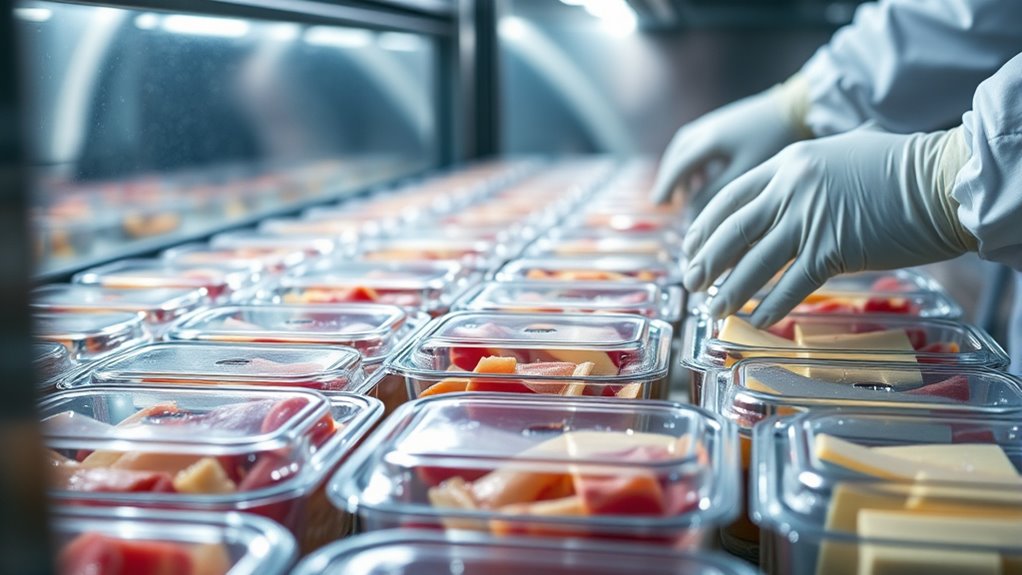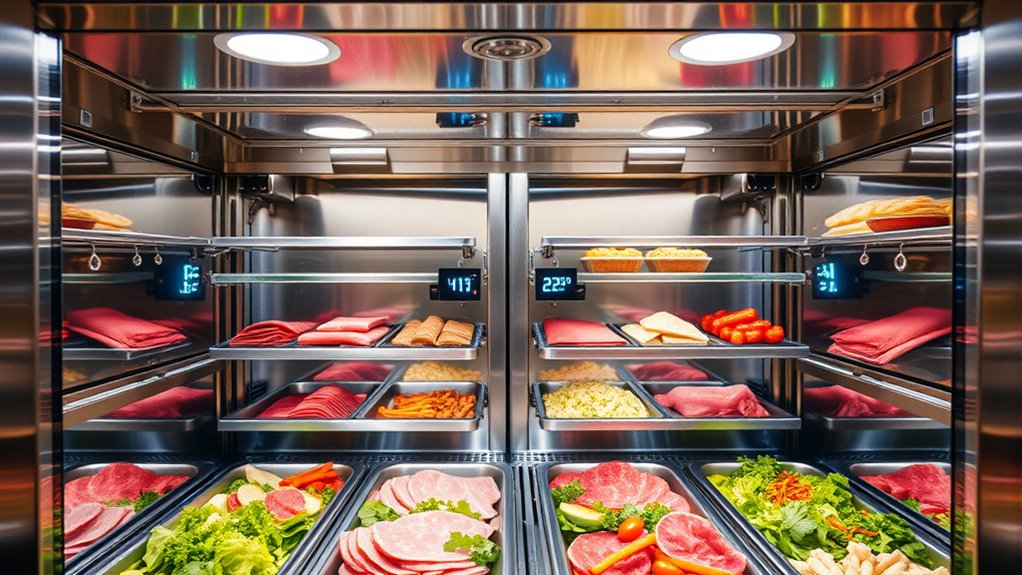To control Listeria in cold-holding, make certain your refrigeration units maintain temperatures at or below 40°F (4°C) at all times, with regular monitoring using calibrated devices. Practice proper food handling by separating ready-to-eat items from raw products, and keep surfaces and storage areas clean and sanitized frequently. Proper documentation and maintenance of equipment are essential, and leveraging technology can enhance your oversight. Keep these practices in mind to effectively prevent bacterial growth—continue to explore ways to strengthen your food safety measures.
Key Takeaways
- Maintain cold-holding temperatures at or below 40°F (4°C) to inhibit Listeria growth.
- Regularly monitor and record temperatures with calibrated equipment for consistent safety.
- Clean and sanitize refrigeration units and surfaces frequently, focusing on hard-to-reach areas.
- Store ready-to-eat foods separately from raw products to prevent cross-contamination.
- Use automated monitoring systems and conduct routine inspections to detect and address temperature deviations promptly.

Have you ever wondered how food safety experts keep Listeria bacteria in check? It all comes down to strict adherence to food safety protocols and consistent sanitation practices. Cold-holding, which involves storing ready-to-eat foods at safe temperatures, is a critical step in preventing Listeria growth. To ensure safety, you need to follow established guidelines precisely. That means maintaining temperatures at or below 40°F (4°C) and regularly monitoring those temperatures with calibrated equipment. Small fluctuations can create an environment where Listeria can thrive, so constant vigilance is essential.
Food safety protocols are designed to create a barrier against bacterial contamination. This includes not only proper temperature control but also procedures for handling, storing, and cleaning. For instance, you should store ready-to-eat foods separately from raw products to prevent cross-contamination. Proper labeling and rotation of stored items are crucial, ensuring older stock is used first and reducing the chance of spoilage or bacterial growth. Implementing a routine schedule for checking temperatures and recording data helps catch issues early before they develop into larger problems.
Proper storage, labeling, and rotation prevent cross-contamination and bacterial growth.
Sanitation practices are equally vital in maintaining a safe cold-holding environment. Regular cleaning and sanitizing of refrigeration units, containers, and utensils help eliminate any Listeria present on surfaces. Use approved sanitizers according to the manufacturer’s instructions, and pay close attention to hard-to-reach areas like door seals and shelving. These spots tend to harbor bacteria if not cleaned properly. It’s important to clean surfaces before sanitizing to remove any organic matter that could inhibit sanitizer effectiveness. Also, establishing a cleaning schedule and training staff to follow it ensures consistency and thoroughness.
You should never underestimate the importance of monitoring and documentation. Record keeping not only helps verify that food safety protocols are being followed but also provides a trail for audits or investigations if contamination occurs. Regular inspection of cold-holding units for signs of spoilage or damage is essential. Check door seals, fans, and temperature alarms frequently, and address issues immediately. Any lapse in sanitation practices or temperature control can lead to bacterial growth, putting consumers at risk. Additionally, the integration of automation technologies in food safety management systems can help improve monitoring accuracy and consistency.
Frequently Asked Questions
How Often Should Cold-Holding Temperatures Be Checked?
You should check cold-holding temperatures at least every 2 hours through regular temperature monitoring. This frequency scheduling helps guarantee foods stay at safe temperatures and prevents bacterial growth. Make it a routine to record each check, and if temperatures fall outside the safe range, take immediate corrective action. Consistent monitoring not only complies with safety standards but also protects your customers from potential foodborne illnesses.
What Are the Signs of Listeria Contamination in Cold-Held Foods?
Did you know that Listeria can grow at refrigerator temperatures? Signs include unusual odors, slimy textures, or discoloration on cold-held foods. You should also rely on visual indicators and microbial testing to detect contamination. If you notice any of these signs, discard the food immediately and check your cold-holding practices. Regular testing helps catch issues early, preventing Listeria from reaching consumers and ensuring food safety.
Are There Specific Cleaning Agents Effective Against Listeria?
Effective disinfectants like chlorine-based solutions, hydrogen peroxide, and quaternary ammonium compounds are proven against listeria. You should follow strict sanitization protocols, ensuring surfaces are thoroughly cleaned and sanitized regularly. Make sure to use the correct concentration and contact time specified by the manufacturer. Proper cleaning and sanitization are essential to prevent listeria growth in cold-held foods, protecting your customers and maintaining food safety standards.
How Long Can Cold-Held Foods Safely Be Stored?
You can typically store cold-held foods safely for up to 4 days if you follow proper food safety policies and maintain your refrigeration units at 40°F (4°C) or below. Regular refrigeration maintenance is essential to prevent temperature fluctuations that could promote listeria growth. Always check for signs of spoilage and adhere to recommended storage times to guarantee food safety and minimize health risks.
What Training Is Recommended for Staff on Listeria Prevention?
You should provide staff with thorough training on listeria prevention, focusing on employee hygiene and hazard awareness. This training must cover proper handwashing, glove use, and sanitizing procedures, along with recognizing potential contamination risks. Regular refresher courses help reinforce best practices. By ensuring your team understands these essentials, you reduce the risk of listeria growth and protect your customers’ health effectively.
Conclusion
To keep listeria at bay, you must stay vigilant and maintain strict cold-holding practices. Regularly clean and monitor your equipment, ensure proper temperatures, and practice good hygiene. Think of your cold-holding areas as a fortress—if you don’t reinforce the walls, intruders like listeria can slip in easily. By staying proactive and diligent, you create a safe environment where bacteria can’t thrive, protecting your food and your customers’ health.









